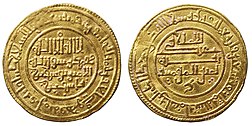The Almoravid dinar (Arabic: الدينار المرابطي) was a gold dinar coin minted under the Almoravid dynasty in the Maghreb and Iberia (al-Andalus).[1][2] The mints that produced them were supplied by the West African gold mines south of the Sahara desert.[1][3] The Almoravid dinars circulated widely beyond the reach of the empire; the Christian kingdoms of Iberia called them "marabotins" and "maravedís".[3]
| الدينار المرابطي (Arabic) | |
|---|---|
 Dinar minted under Yusuf ibn Tashfin in Aghmat. |
History
editWhen the Almoravids conquered Awdaghust around 1054, they gained control over the southern point of the trans-Saharan trade routes.[1] When Abu Bakr ibn Umar led the capture of the Sijilmasa oases from the Maghrawa, they occupied the northern point.[1] In this position, the Almoravids were able to control and profit from the trans-Saharan gold trade.[1] Within two years of taking Sijilmasa, the entry point for gold into North Africa, dinars were struck there in the name of Abu Bakr ibn 'Umar.[1]
When Yusuf ibn Tashfin officially became amir of the Almoravids in 1087, coins were struck with his name and the volume of production increased.[1] In addition to Sijilmasa, coins were struck in several new mints, the first of which was in Aghmat in 1093.[1] The mint in Aghmat had the highest output of any mint in North Africa until 1122, and Muhammad al-Idrisi noted in Nuzhat al-Mushtāq that under the Almoravids the population of Aghmat was the wealthiest.[1]
From around 1096, Almoravid dinars were struck in al-Andalus, starting in Seville.[1] There was a notable increase in production around 1104, the year after Ali ibn Yusuf was recognized as the heir to the empire; these coins featured his name along with his father's.[1] Ronald A. Messier suggests that this was "aimed at publicizing the legitimacy of Ali's 'right' to the throne."[1]
Under Ali, coin production greatly increased. Dinars were minted in Marrakesh, the newly established Almoravid capital, from around 1097.[1] Four years later, they were also being minted in Fes, Tlemcen, and Nūl Lamta.[1] The multiple cities minting coins helped the Almohad sultan solidify his control over distant parts of his empire; his name on the coins functioned as a sort of brand and symbol of authority to preempt possible revolts.[1]
The greatest extent of Almoravid dinar production started around 1120 and lasted until around 1130; it was the peak of Almoravid prosperity when most of Ali's constructions took place.[1] The most productive Andalusi mints at this time were in Almería, Seville, and Granada—the most important cities for international commerce.[1]
With the threat of Ibn Tumart and the Almohad movement, Ali shifted his attention to the African part of his empire.[1] Around 1130, more Almoravid dinars were made in Africa than in Iberia.[1] From 1139 to 1146, Ibn Tumart's Almohads waged total war on the Almoravids until finally conquering Marrakesh.[1] The economic effects of this conflict could be felt even in 1141, when Fesi merchants complained of the Almohad "usurpers."[1]
The last Almoravid sultan, Ishaq ibn Ali, and some unknown Almoravid rebels minted a few dinars from 1146 to 1151.[1]
- Almoravid coins and coinage molds found in Algiers, National Museum of Antiquities and Islamic Art.
-
Almoravid coinage mold, 1117-1116.
-
Almoravid coinage mold, 1117-1116.
-
Golden coins of the Almoravid dynasty.
Circulation
editThe Almoravids traded virtually exclusively with locally produced dinars.[1] Under the Almoravids, al-Andalus exported goods to North Africa, Egypt, and France, among others. It also imported goods from many different areas, including China, India, Persia, the Middle East, North Africa, and Europe.[1] Because of the extensive trade network of the Almoravids and the reputed quality of their coins, Mediterranean markets were flooded with Almoravid dinars for almost a century, and they competed with the Fatimid dinar as the dominant currency of Mediterranean trade.[1]
References
edit- ^ a b c d e f g h i j k l m n o p q r s t u v w x y Messier, Ronald A. (1980). "Quantitative Analysis of Almoravid Dinars". Journal of the Economic and Social History of the Orient. 23 (1/2): 102–118. doi:10.2307/3632235. ISSN 0022-4995. JSTOR 3632235.
- ^ Messier, Ronald A. (March 1974). "The Almoravids: West African Gold and the Gold Currency of the Mediterranean Basin". Journal of the Economic and Social History of the Orient. 17 (1): 31–47. doi:10.2307/3596249. ISSN 0022-4995. JSTOR 3596249.
- ^ a b "Qantara - The Almoravid dynasty (1056-1147)". www.qantara-med.org. Retrieved 2020-05-25.